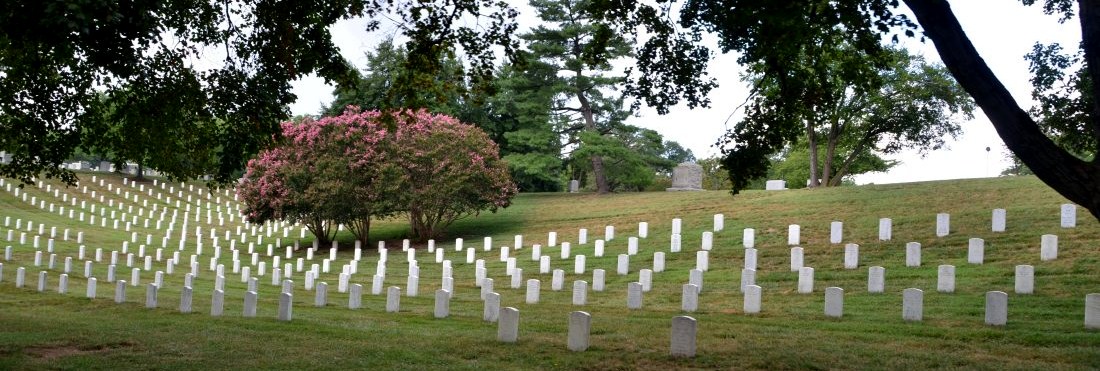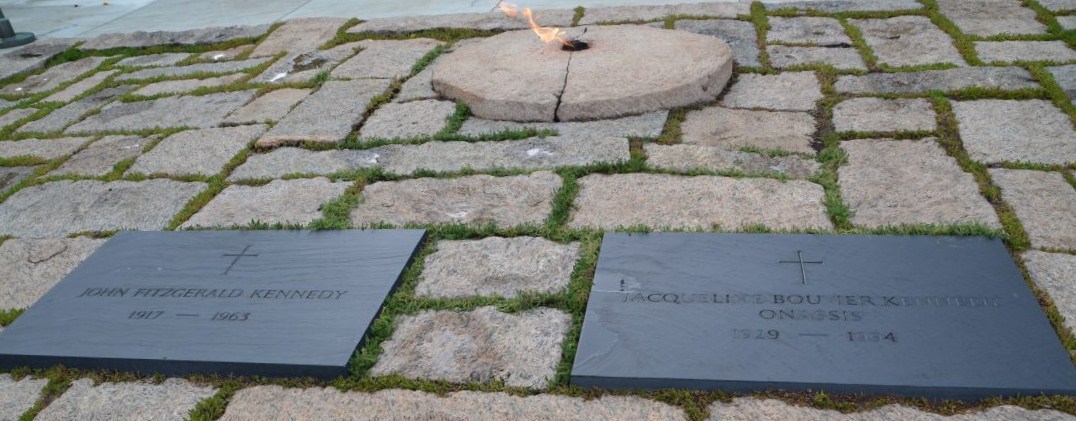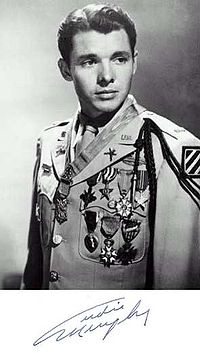Arlington Cemetery

|
Arlington National Cemetery
Arlington National Cemetery, Arlington County, Virginia, is a military cemetery, established during the American Civil War on the grounds of Arlington House, formerly the estate of the family of Confederate general Robert E. Lee's wife Mary Anna (Custis) Lee, a great grand-daughter of Martha Washington. The cemetery is situated directly across the Potomac River from the Lincoln Memorial, Washington, D.C.. It is served by the Arlington Cemetery station on the Blue Line of the Washington Metro system. Standing on an area of six hundred and twenty four acres, veterans and military casualties from each of the nation's wars are interred, ranging from the American War of Independence, American Civil War through to the military actions in Afghanistan and Iraq. Pre-Civil War dead were reinterred after 1900. Arlington National Cemetery and United States Soldiers' and Airmen's Home National Cemetery are administered by the Department of the Army. The other national cemeteries are administered by the Department of Veterans Affairs or by the National Park Service. Arlington House (Custis-Lee Mansion) and its grounds are administered by the National Park Service as a memorial to Lee.
History: George Washington Parke Custis, grandson of Martha Washington and step-son of George Washington, inherited the land in 1802. Raised as the nation's first presidential son, Custis dedicated his life to the commemoration of the first president. Between 1802 and 1818, he built Arlington House as the centrepiece of his eleven hundred acre plantation. It was the nation's first memorial to George Washington and a home for the growing Custis family. In 1831 Custis' and his wife Mary Lee Fitzhugh's only surviving adult child Mary Anna Custis married Lt. Robert E. Lee, a West Point graduate and US Army officer in the front parlor of Arlington House, for the next thirty years Arlington House became home to one of America's most famous soldiers and his family. When Fort Sumter was forced to surrender at the beginning of the American Civil War, President Abraham Lincoln offered Lee command of the federal army. Lee demurred, waiting to see if his native Virginia would decide to secede. (Lee said "I will not fire at my fellow Virginians"). When Virginia announced its decision, Lee resigned his commission at Arlington House on the 20th of April 1861 and took command of the armed forces of the Commonwealth of Virginia, later becoming commander of the Army of Northern Virginia. He quickly established himself as an able commander, defeating a series of Union generals, until his final defeat and surrender at the McLean House. Because of this decision and subsequent performance, Lee was regarded as disloyal by most Union officers. By the end of May 1861, the Lees had vacated the property and federal troops occupied the estate, using the house as its headquarters. In 1863 Freedman's Village was established on the estate to assist refugee slaves in their transition from slavery to freedom. Some of the first burials on the estate were residents of Freedman's Village. American military cemeteries developed from the duty of commanders on the frontier and in battle to care for their casualties. When Civil War casualties overflowed hospitals and burial grounds near Washington, D.C., Quartermaster General Montgomery C. Meigs proposed in 1864 that two hundred acres of the Robert E. Lee family property at Arlington be confiscated for a cemetery. On the 13th of May, the first military burial took place in what is know known as Section 27. By the end of the Civil War there were nearly sixteen thousand buried on the old plantation, soldiers from both the North and the South.
The view over Washington from the Kennedy burial plot. Robert Kennedy's simple white cross and plaque
The government acquired Arlington at tax sale in 1864 for $26,800.
Mrs. Lee had not appeared in person, but rather had sent an agent, attempting to
timely pay the $92.07 in property taxes on the estate. The government turned
away her agent, refusing to accept the tendered payment. In 1874, Custis
Lee, heir under his grandfather's will passing the estate in trust to
his mother, sued the US claiming ownership of Arlington. After the Supreme
Court ruled 5-4 in Lee's favour, deciding that Arlington had been confiscated without due process,
Congress returned the estate to him. The next year, Custis Lee sold it back to
the government for $150,000 at a signing ceremony with Secretary of War
Robert
Todd Lincoln. Military burials were previously held at the US
Soldiers' National Cemetery in Washington, D.C., but it was quickly filling. "We pray for those
who lost their lives," Meigs wrote, "The grounds about the mansion are admirably
adapted to such a use." Burials had, in fact, begun at Arlington before the ink
was even blotted on Meigs's proposal. The southern portion of the land now occupied by the cemetery was used during and after the Civil War as a settlement for freed slaves. More than 1,100 freed slaves were given land at Freedman's Village by the government, where they farmed and lived during and after the Civil War. They were evicted in 1888 when the estate was repurchased by the government and dedicated as a military installation. President Herbert Hoover conducted the first national Memorial Day ceremony in Arlington National Cemetery, on the 30th of May 1929. The US Army began restoring the house and slave quarters in the early 1930's. In 1933 the house was transferred into the care of the National Parks Service.
African American Soldiers Memorial and the Nurses Memorial
Sections: Arlington National Cemetery is divided into seventy sections, with some sections in the southeast portion of the cemetery reserved for future expansion. Section 60, in the southeast part of the cemetery, is the burial ground for military personnel killed in the Iraq War and the War in Afghanistan. In 2005, Arlington National Cemetery acquired twelve acres of additional land from the National Park Service, along with seventeen acres from the Department of Defense that was part of Fort Myer and forty four acres that is the site of the Navy Annex. Johnny Clem, a ten year old drummer boy during the Civil War who attained the rank of sergeant by the age of twelve is buried here. In Section 1 James McCubbin Linghan, a Revolutionary War veteran and advocate of free speech is buried along with eight of his brothers in arms. President William H. Taft - the 27th US President is here too in Section 30. The Kennedy family are In Section 45.
We saw the intricate memorial to the soldiers who lost their lives in Iwo Jima to the Crew of the Space Shuttle Columbia
Section 21, also known as the Nurses Section, is the area of Arlington National Cemetery where many nurses are buried and is the site of the Nurses Memorial. In 1901, Confederate soldiers buried at the Soldiers' Home and various locations within Arlington were reinterred in a Confederate section that was authorized by Congress in 1900. On the 4th of June 1914, the United Daughters of the Confederacy dedicated a monument designed by Moses Ezekiel. Upon his death in 1917, Ezekiel was buried at the base of the monument as he was a veteran of the Confederate army. All Confederate headstones in this section are peaked rather than rounded. More than 3,800 former slaves, called "Contrabands" during the Civil War, are buried in Section 27. Their headstones are designated with the word "Civilian" or "Citizen". In 1915, the mast of the battleship USS Maine was relocated to Arlington to honor the two hundred and sixty men who were killed when the ship was struck off Cuba in 1898. This memorial significantly raised the nations consciousness. There are now memorials to all branches of the military. There is a memorial to those who lost their lives on 9/11. As well as war dead sports, science, engineering, medicine, exploration, Supreme Court, politics are all represented by the people laid to rest here.
Grave markers, niches and headstones: The United
States Department of Veterans Affairs oversees the National
Cemetery Administration's orders for placement of inscriptions and faith emblems at no
charge to the estate of the deceased, submitted with information provided by the
next of kin that is placed on upright marble headstones or columbarium niche
covers. The Department of Veterans Affairs currently offers thirty nine
authorised
faith emblems for placement on markers to represent the deceased's faith. This
number has grown in recent years due to legal challenges to
policy. Prior to 2007, the United States Department of Veterans Affairs (VA) did not allow the use of the pentacle as an "emblem of belief" on tombstones in military cemeteries. This policy was changed following an out-of-court settlement on the 23rd of April following a series of lawsuits against the VA. Between 1947 and 2001, privately-purchased markers were permitted in the cemetery, but the areas in which the cemetery permitted such markers are now filled. Nevertheless, the older sections of the cemetery have a wide variety of private markers placed prior to 2001, including artillery pieces.
John Kennedy (the 35th President) next to Jacqueline, either side a son and daughter and the eternal flame
The persons below are eligible for ground burial in Arlington
National Cemetery. The last period of active duty of former members of the Armed
Forces must have ended honorably. Interment may be casketed or cremated remains.
Audie Leon Murphy (20th of June 1924 – 28th of May 1971) was a fifth grade dropout from an extremely poor family who fought in WWII. Through "LIFE" magazine's 16th of July 1945 issue ("Most Decorated Soldier"/cover photo), he became one the most famous soldiers of World War II and widely regarded as the most decorated American soldier of the war. After the war he became a celebrated movie star for over two decades, appearing in 44 films. He also found some success as a country music composer. During twenty-seven months in action in the European Theatre he received the Medal of Honor, the US military's highest award for valor, along with 32 additional US and Foreign awards (medals, ribbons, citations, badges...) including five awards from France and one from Belgium. Murphy's successful movie career included To Hell and Back (1955), based on his book of the same title (1949). He died in a plane crash in 1971 and was interred, with full military honors, here in Arlington Cemetery. He is not as we thought the most decorated of people laidto rest here. That honor goes to..........
Lieutenant Colonel Matt Louis Urban (25th of August 1919 – 4th of March 1995) - nicknamed The Ghost - was a US Army infantry officer who served with distinction in the European Theater of Operations in World War II. He scouted, led charges upfront, and performed heroically in combat on several occasions even after being wounded. He was awarded over a dozen combat decorations by the Army. In 1980, he was awarded and presented the Medal of Honor and four other combat decorations belatedly for repeated acts of heroism in combat in France and Belgium in 1944. The Guinness Book of World Records in 1989, considered Urban to be the United States Army's most combat decorated soldier of World War II.
The Sullivan brothers are all buried here (own blog) a surname from my childhood.
Bear had said as we walked from the bus that my new habit of museum window shopping would probably not be fulfilled here, wrong, a very nice shop - fridge magnet and pin soon purchased. But seriously............. So often in films and television series we have seen Arlington Cemetery featured, the twenty one gun salute, the close family sitting near the casket and the ceremonial folding of the Stars and Stripes. We felt the need to visit this amazing place of rest.

ALL IN ALL A MUST FOR US TO VISIT THIS PLACE OF
HONOR AND MEMORIES |













